In July we hosted not one but three residential engineering summer schools, seeing over 160 students visit and stay at the University to learn about Ship Science.
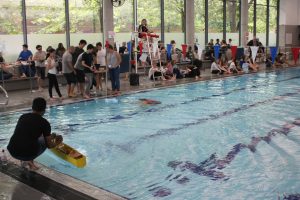
It all started with the newly designed Smallpeice Course thanks to Drs’ Arun, Francesco and Yikun! This course saw Year 9 students design, build and test wave energy converters and supply vessels.
Filming the action at smallpeice trials
This was followed by the Marine Headstart course led by Dr Joe Banks where Year 12 students designed, built and tested tidal turbines – learning all about renewables, ship science and marine engineering.
While last but not least the Design Triathlon Summer School led by Dr Nick Townsend saw Year 12 students design, build, test and race speedboats – learning all about hydrostatics, hydrodynamics and the design process.
Thanks to all those who participated and the staff and phd student who helped out over the week – it was great fun for all.
If you would like to know more about these courses and engineering outreach at the University of Southampton be sure to check out. Similar course will take place next year and are a great opportunity to learn about maritime engineering and ship science and possible careers that follow.
http://www.etrust.org.uk/marine-engineering-and-nautical-science-southampton
https://www.southampton.ac.uk/schools-colleges/design-triathlon.page
https://www.southampton.ac.uk/schools-colleges/marine-headstart.page
All posts by Stephen Turnock
Delphin2 in starring role
Our long serving Autonomous Underwater Vehicle Delphin 2 features in a short 15 minute film highlighting the capabilities of autonomous vehicles to support emergency and disaster relief activities. This was made as part of an EPSRC funded UK Robotics Week Grand Challenge entry.
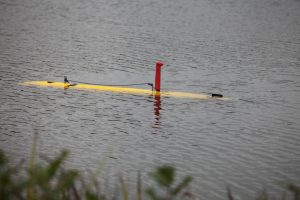
The première was well attended and a very enjoyable occasion, attracting three classes from the local school whose students were in the film as well as parents and teachers.
The film is now on YouTube for all to see https://youtu.be/eD742AI21fk
If you watch this you will of course see Delphin2, a small surface ASV and our own Dr Jon Downes making his film debut!
Good vision is everything
The marine imaging workshop 2017 in Kiel was the second workshop of this kind, bringing together engineers, researchers regulators, and industrial partners who are involved in acquiring visual imagery in the marine realm. To represent the engineering side of this challenge, Dr Blair Thornton and Sophia Schillai travelled to the GEOMAR Helmholtz Centre for Ocean Research in Kiel; Blair presented how he uses classical photography in combination with structured light from a laser to produce multi-hectare 3D Visual Maps that can be used to quantify the distribution of benthic organisms. Sophia brought a poster on the terrain following challenges for flight style AUV.

Besides presentations the workshop included several sessions for discussions on the future of marine imaging, giving a large and diverse platform to exchange what is important to those who use the data and where the challenges in aquiring and processing the data lie.
This was rounded off by a tour of the GEOMAR facilities, where on top of a diverse spectrum of research areas they were amused by the discovery of a museum model of the AUV ABYSS. It was made for a special exhibit, on of many ways how Germany involves the public in the science theme of 2017: The year of the oceans.
Shortly afterwards the annual VLC awayday conference brings together all students whose research is with the ECS group Vision, Learning, and Control (VLC). This includes several PhD students with FSI, but this year our group was also represented by Dr Blair Thornton giving the keynote. He showed how the often quite abstract research on Vision, Learning and Control is vital to getting a larger scale insight to the oceans. They cover 70% of our planet, but challenges from analysis of deep sea minerals to discovering deep-sea benthic ecosystems or monitoring the environment following disasters such as the Fukushima nuclear accident can only be solved at a large scale by applying advanced computational techniques.
PhD student Sophia completed the insight in the collaborative work between FSI and VLC by showing her work on improving the capability of flight style AUV, like Autosub6000 or BoatyMcBoatface from NOC, to stay close to complex terrains for photographic studies. Her presentation was awarded the runner-up award for the best presentation of the day.
OCEANS IV
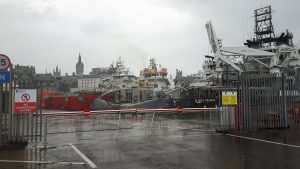
Between the 19th and 22nd June the FSI group was represented by PhD students Yu Cao and Bernat Font Garcia, as well as postdoctoral researches Francesco Giorgio-Serchi and Artur Lidtke at the Oceans ’17 conference in Aberdeen, Scotland.
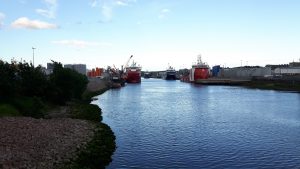
The event covered a very wide range of topics, from aquaculture, sensor technologies through to signal classification along with many more applied papers relevant to offshore structures and renewable energy. The papers presented by FSI researchers included a study of a mixed renewable energy scavenging device for an autonomous vehicle (Yu Cao https://pure.soton.ac.uk/admin/files/23591223/161201_132.pdf), development of a turbulence model for application to vortex induced vibration on riser pipes and moorings (Bernat Font Garcia https://www.researchgate.net/publication/316734503_Analysis_of_two-dimensional_and_three-dimensional_wakes_of_long_circular_cylinders), testing of a soft robot utilising shape change to propel itself (Francesco Giorgio-Serchi https://eprints.soton.ac.uk/410902/1/GiorgioSerchi_Weymouth_Oceans2017.pdf), and an experimental study of laminar flow effects on an underwater glider wing (Artur Lidtke https://eprints.soton.ac.uk/411106/).

The conference was also preceded by a day of workshops and tutorials devoted to modelling marine renewable energy devices and design of autonomous underwater vehicles (AUV). Both subjects of significant interest to many within FSI.
Summer Open day opportunities – learn more about ship science, naval architecture and marine engineering
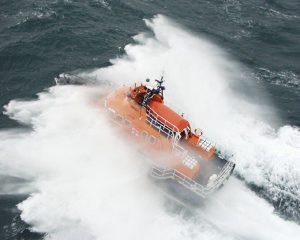
For many the maritime sector is not one they may know much about but there are many exciting careers in the industry, with plenty of opportunities to travel, work abroad and not just to always sit behind a desk at a computer. Our graduates are highly sought after in the industry and can be found in leadership positions worldwide and across a range of sectors from cruise ships, America’s Cup team, offshore industry, ship design and consultancy, marine renewables, defence sector, academia and even Silicon Valley. We are the only degree programme in the UK which is accredited by the Royal Institution of Naval Architects, Institute of Marine Engineering, Science and Technology, and the Institution of Mechanical Engineers. There are exciting engineering challenges in the maritime sector from how do we decarbonise shipping, protect lives at sea, maritime robotics, develop cost effect marine energy harvesters for wind, wave and tide to name but a few.
For those studying hard at school who are interested in the maritime engineering sector we have four open days this summer. Staff and students will be on hand to answer questions and show some of our facilities and educational experience. Our degree course cover a wide range of the maritime sector and provide great flexibility. We look for strong grades in maths and a suitable science such as physics, chemistry or further maths. Our admissions team is always happy to answer question either by email or phone.
This summer’s University open days are taking place on Saturday 8th July, Saturday 9th and Sunday 10th September and Saturday 14th October. To book for the 8th July or register an interest and find out more http://www.southampton.ac.uk/about/visit/open-days.page . It will be great to meet you and explain more.
Part 2 Ship Science Students Tour China's Maritime Sector

For the second year our second year ship science students have been able to visit ship yards and maritime organisations in China on a 10 day whistle stop tour. The opportunity to visit a variety of ship yards building ships, performance yachts, offshore platforms as well as some of the leading maritime universities and research organisations has been made possible because of a number of on-going educational partnerships between the Faculty of Engineering and Environment and our colleagues in China,
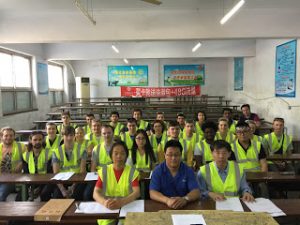
If you want to find out more please find our direct from the student’s blog at csiv2017.blogspot.com. There are some great shout outs to Dr Boyd’s ship production course being seen in action and my personal favourite about the need to reduce the drag of ship rudders..
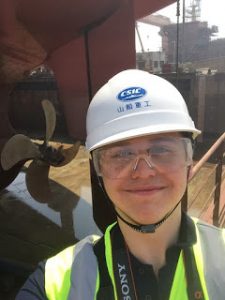
Long service on board ship science…
A recent innovation at the University of Southampton has been the introduction of a recognition award for long service at 20 years (a glass bowl) and 30 years (a carriage clock). Six members of staff in Fluid Structure Interactions were eligible. Presentations were made by our Head of Academic Unit, Prof Penny Temarel. (Top left) to Prof Ajit Shenoi for 30+ years, (Top middle) by Prof Shenoi to Prof Temarel for 20+ years, (Top Right)PT to Dr Mingyi Tan for 20+ years, (Bottom Left) PT to Prof Dominic Hudson for 20+ years, (Bottom Middle) PT to Prof Stephen Turnock for 20+ years and (Bottom Right) PT to Prof Philip Wilson for 30++ years!
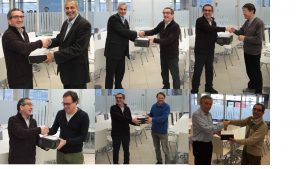
SHIP SCIENTISTS VISIT WALLENIUS WILHELMSEN CAR CARRIER, TOLEDO
Second year students Miri Park and Moriba Konate report:
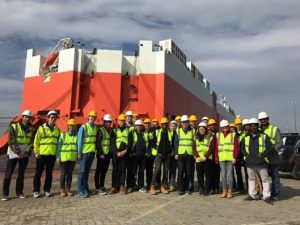
The second year ship science students had the privilege of visiting the car carrier, Toledo at the Southampton dock. The Japanese built 200m ship had 12 tiers of car decks with the total capacity of 6564 units of passenger cars.
Before going on board, the students spoke to the engineers from Ecosubsea, a company which uses remotely controlled mini-submarines to clean underwater hull. The engineers highlighted the importance of protecting the hull from fouling and how a clean hull with minimal paint damage helps to reduce air pollution and fuel costs for a ship. This allowed the students to acknowledge the growing environmental issues and the needs for regulations on ships.
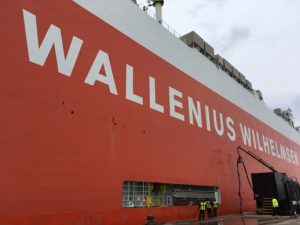
On the bridge, the electronic chart display and information system (ECDIS) was shown by the chief engineer, which helps the navigation crew to monitor the ship and plan the route in advance. However, in contrast to this technological advancement, a signalling lamp was still in use and it was explained that all crew must know the Morse code. The ballast control system was shown and the students watched how it automatically ballast and deballast during the loading process.
The students were taken around the accommodation space, including the galley, mess rooms, offices and gym, which helped to get an idea for their general arrangement assignment and to see why it is important to provide recreational spaces and a habitable environment for the crew as a naval architect.

Overall, the visit was a success and the shaft tunnel and the steering gear system was most memorable for the students. This helped to understand the importance of shaft alignment and its maintenance during service and it further reinforced their understanding of lecture materials. We are all very thankful to Wallenius Wilhelmsen for this opportunity and hope to see you again!
Brightest and best: – opportunities available
 Fluid structure interactions is looking for able individuals with a background in engineering, maths or physics who wish to deepen their research skills by carrying out PhD research. Our group of 40+ PhD students is a vibrant community although focussed in maritime engineering applications but with many links to other research groups both within Southampton and internationally.
Fluid structure interactions is looking for able individuals with a background in engineering, maths or physics who wish to deepen their research skills by carrying out PhD research. Our group of 40+ PhD students is a vibrant community although focussed in maritime engineering applications but with many links to other research groups both within Southampton and internationally.
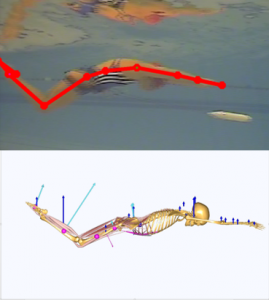
A number of immediate opportunities are listed below but it is always worth contacting any of our members of staff directly to see what other opportunities they might have. The applications process itself can be accessed via the on-line link.
The following projects are currently on offer covering some of our diversity associated with the hydrodynamics of swimming and the musco-skeletal system, reducing the climate change impact of international shipping, exploring the challenges of autonomous surface vessels for environmental monitoring, finding new approaches for maritime design optimisation.
Assessing the impact of hydrodynamic loads on shoulder joint injuries in swimming, contact Dr Joe Banks
A High Temporal Resolution Study of Sediment Deposition At River Mouths Using Persistently Present Autonomous Surface Vehicles contact Dr Jon Downes
Reducing shipping emissions through accurately quantifying ship powering performance using statistical analysis of operational data contact Professor Dominic Hudson
Modelling ship selection and operational usage decisions under uncertainty – towards a better understanding of GHG emissions in international shipping contact Professor Dominic Hudson
Assessment of ship powering performance using machine learning techniques contact Professor Dominic Hudson
Re-imagining the genetic algorithm with application to marine engineering design contact Dr Adam Sobey
GDP 19: Atlantis Deep Sea Research Platform
Only 5% of the world’s ocean floor have been mapped, collecting data at these depths provides a significant challenge. This project aims to design a deep-sea research platform, in the form of an Autonomous Underwater Vehicle.
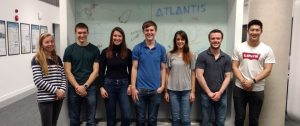
If you want to find out more about the project, please visit our Facebook page: https://www.facebook.com/AtlantisUnderwaterRobot/ The robot will do the following;
- Travel to depths of 100m.
- Carry a payload of sensors and cameras that can collect images and data.
- Uses a flapping foil mechanism for propulsion.The robot will be bioinspired with oscillating foil propulsion; this will provide increased manoeuvrability.
This project involves designing, building and testing a full-scale robot. The team will carry out the following tasks to complete the project:
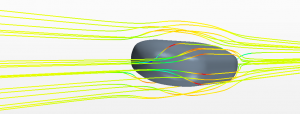
- Developing the conceptual design
- Modelling and optimising an interacting flapping foil mechanism
- Carrying out material testing for the hull and foil materials to determine if they can withstand operating conditions at 100m depth
- Modelling the hull under operating conditions using FEA, and reinforce the structure where necessary
- Manufacturing and testing the separate elements of the AUV
- Programming the AUV so it is capable of operating autonomously underwater, navigating a pre-set path.
- Test the robot at a depth of 3m
